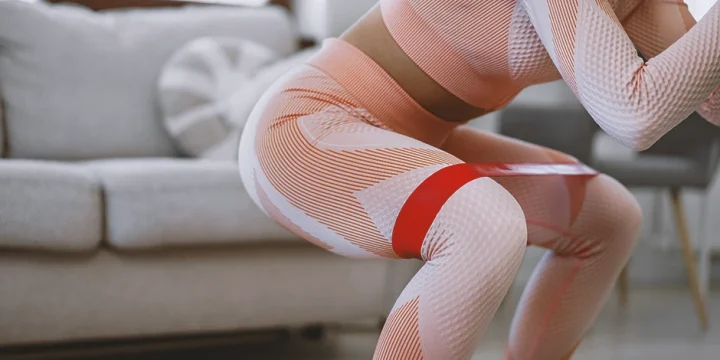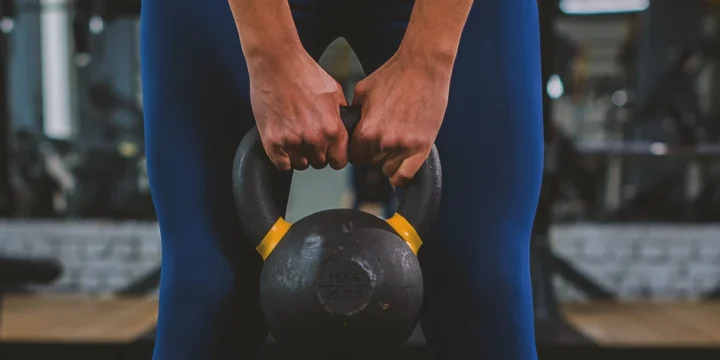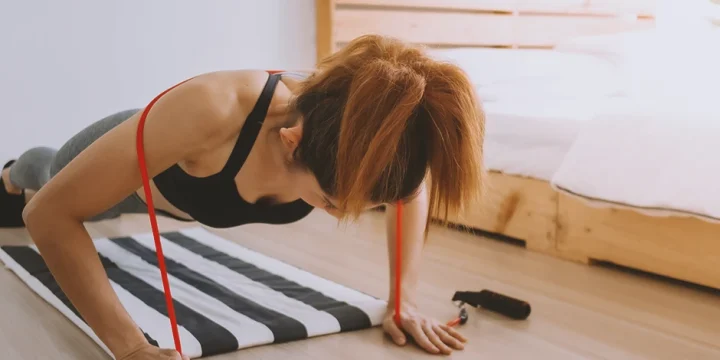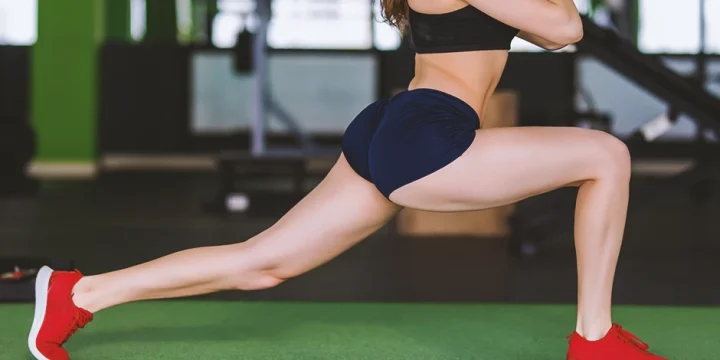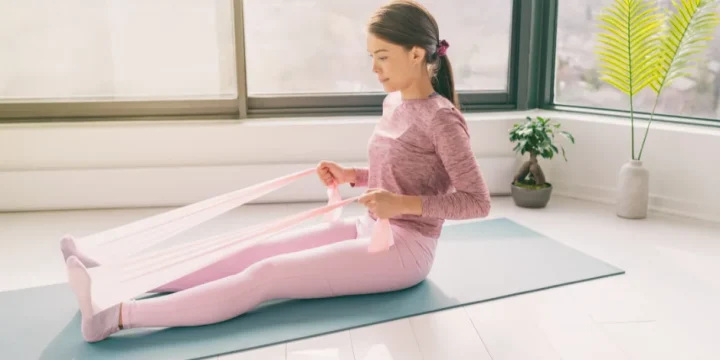Resistance bands are often overlooked by most lifters. In my experience, they’re an incredible workout tool that delivers impressive results, almost as much as heavy weights.
What's more, they strengthen and stretch your muscles simultaneously, providing relief when they are tight or achy.
As a fitness instructor, I’ve experimented with countless resistance band leg exercises and observed amazing results in muscle strength and flexibility.
In this article, I’ll share some of my favorite resistance band exercises and how they can benefit your workout routine.
Quick Summary
- The best resistance band exercises for legs include squats, leg lifts, lateral squat walks, glute kickbacks, banded reverse lunges, hamstring curls, and hip thrusts.
- Power bands are suitable for most workouts, including stretches, resistance exercises, and strength training, while tube bands work best for exercises that require anchoring.
- According to a study from the Journal of Physical Therapy Sciences, resistance bands exert less pressure on joints, making them ideal for individuals with knee pain or older population.
- To make the most out of your resistance band exercises, we recommend using varying band tensions, altering exercise complexity, and increasing volume and intensity.
Resistance Band Exercises for Legs

Based on my various workout programs and research, I've put together seven resistance band leg exercises that hit every major muscle group to help you develop symmetrical, well-proportioned leg muscles.
1. Resistance Band Squats
Besides being the king of all exercises, I believe the squat is a fundamental and highly efficient compound exercise for strengthening the legs.
Using a resistance band in squats can increase the intensity of the exercise while potentially enhancing proper form.
Follow these steps to perform banded squats:
- Stand with your feet shoulder-width apart and place a favorite home gym resistance band above your knees.
- Extend your arms out in front of you.
- Engage your glutes and core, and lower into a squat position by pushing your hips back and down.
- Push your knees against the resistance band and maintain pressure on your heels.
- Rise back up by pressing through the ground and standing tall.
- Repeat for reps.
Related Articles:
2. Resistance Band Leg Lifts
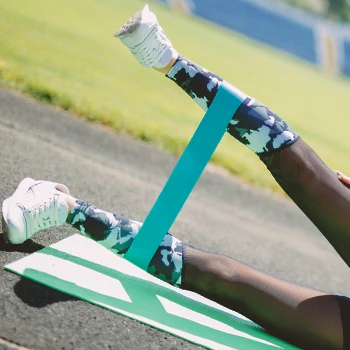
This hip abduction exercise isolates and engages the smaller muscles in your glutes. I usually recommend it as a warm-up for powerlifters before they squat and deadlift for glute engagement.
By performing resistance band leg lifts, you actively work on spreading your thighs apart, further enhancing the engagement of your glutes and thighs.
Here are the steps to do banded leg lifts:
- Wrap a resistance band around your ankles and stand with your feet flat, hip-width apart.
- Engage your inner and outer thighs, and shift your weight onto your right leg.
- Raise your left leg to the side, stretching the band while keeping your hips stable.
- Maintain control as you bring your left foot back to the starting position without letting it touch the ground.
- Repeat for reps.
3. Lateral Squat Walk
The lateral squat walk exercise requires performing a squat motion while taking sideways steps instead of moving directly forward or backward.
To perform a lateral squat walk:
- Position a band approximately six inches above your knees.
- Stand with your feet hip-width apart, creating tension in the band to engage your glutes.
- Lower into a loaded squat position, keeping the weight in your heels and maintaining an upright chest.
- Hold the loaded squat position and take two lateral steps to your right, stretching the band to its maximum extent.
- Bring your left foot in, tapping it towards your right foot while keeping a low squat position.
- Step out with your left leg, maintaining tension in the band, and bring your right leg towards the left, meeting your outside foot.
- Repeat for reps.
4. Glute Kickbacks
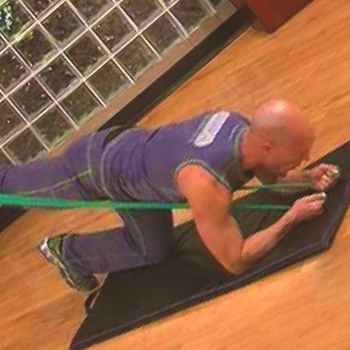
The glute muscles are the largest and most powerful muscles in your body.
They’re crucial for hip extension, rotation, and pelvis stabilization. Glute kickbacks engage your glute muscles by isolating them and incorporating a full range of motion.
Here's how to perform glute kickbacks:
- Begin in a hands-and-knee position, with one end of the resistance band evenly placed under both hands.
- Wrap the other end of the band around the sole of your foot.
- Maintain a square position with your hips and engage your core as you straighten your one leg backward.
- Return to the starting position, and repeat for reps.
5. Resistance Band Reverse Lunge
While traditional lunges are effective for targeting the quadriceps, I find better results when performing them with a resistance band due to the forward-stepping motion.
Here are the steps to perform a banded reverse lunge:
- Wrap a resistance band underneath your right foot, bringing it behind your shoulders and in front of your neck.
- Hold the band with your hands, keeping it at a comfortable distance from your neck.
- Stand in an upright position with your feet hip-width apart.
- Place your hands together in front of your upper body, elbows bent and positioned by your shoulders.
- Maintain an upright torso and take a step backward with your left foot.
- Lower your body until one leg is bent at least 90 degrees and your other knee is close to touching the ground.
- Push yourself back up to the starting position and repeat for reps.
6. Banded Hamstring Curls
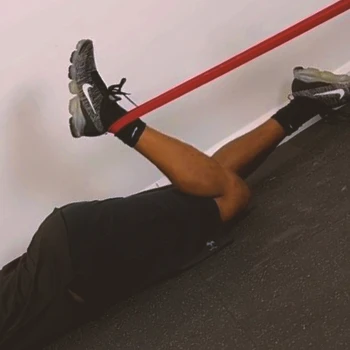
Banded hamstring curls improve your performance in squats and deadlifts while sculpting and defining your legs’ posterior muscles. It's been a boon for my weightlifting and powerlifting clients.
Follow these steps to perform banded hamstring curls:
- Begin by securing the resistance band around a stationary object, such as a pole or frame.
- Create a slipknot by looping one end of the band through the other.
- Once the band is attached, hold the other end and walk a few steps away from the anchor point.
- Lie down on your chest.
- Place the band around your ankles, ensuring that your feet are slightly apart to maintain tension in the band.
- Straighten your legs as much as possible and pull your heels toward your hips, engaging your hamstrings.
- Slowly lower your legs back down while keeping tension on the muscles.
7. Banded Hip Thrust
This resistance band exercise enhances strength and hip mobility and strengthens the hamstrings.
To perform a banded hip thrust:
- Attach the ends of a resistance band to two anchor points on your sides, ensuring sufficient tension.
- Position yourself underneath the band, similar to how you would set up for a hip thrust with a barbell on your hips.
- Keep your knees bent at a 90-degree angle and rest your upper back on a bench or stable elevated surface.
- Perform hip thrusts, focusing on holding at the top and lowering the movement slowly.
Who Should Do Resistance Band Leg Exercises?
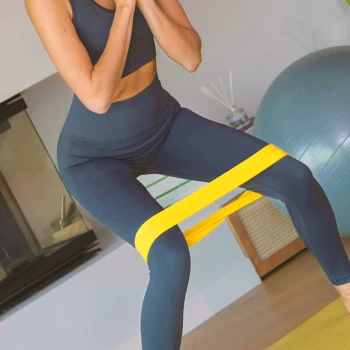
People who prefer working out at home or want fresh training variations in their lower body routine should do resistance band leg exercises. However, resistance band training may not provide sufficient mechanical loading and stress for stronger individuals.
We recommend you include these exercises towards the end of a workout session after performing compound exercises with heavier loads.
Types of Resistance Bands for Leg Exercises

There are various types of bands, each offering a different level of resistance. We’ll look at two commonly used ones.
Power Bands
Power loop bands offer many uses, including bodyweight assistance, resistance training, full-body workouts, physical therapy, warm-ups, and stretching [1].
You can combine them with free weights for added resistance and anchor them for pulling, pushing, and rehabilitation exercises.
These versatile bands cover all planes of motion and can be used for various training goals, from athletic performance to bodybuilding.
Tube Bands
Tube resistance bands are designed with handles on both ends, allowing them to replicate exercises typically done with gym machines or dumbbells. You can anchor them to a door or bar/pole.
These bands are ideal for individuals just starting out or for lighter-weight exercises such as hip abductions. They are particularly convenient for exercises that require anchoring.
“Resistance bands are great because you can bring them with you anywhere, and there are varying degrees to make it more challenging, or scale it back.”
- Betina Gozo, Nike Master Trainer
Workout Benefits

Here are the benefits of resistance band leg exercises:
- Muscle development: Banded weight training typically targets and tones the large muscle groups in your legs and glutes. Adding resistance forces these muscles to work harder during exercises, leading to increased muscle mass and fat burning in the lower body [2].
- Improved leg shape: Regular resistance band leg workouts can transform the appearance of your legs, making them tighter and more defined.
- Joint-friendly workout: According to a study from the Journal of Physical Therapy Sciences, resistance bands exert less pressure on joints, making them ideal for individuals with knee pain or older populations [3].
- Versatility and convenience: Resistance bands are highly versatile and target various muscles. They are portable and require minimal space, allowing for convenient workouts at home or while traveling.
“Resistance bands workouts also strengthen the back, shoulders and core muscles, which can improve posture and stability.”
- Jen Skym, Personal Trainer
Combining Resistance Bands with Other Equipment for a Dynamic Leg Workout
One of the best ways to enhance the effectiveness of resistance band leg workouts is to incorporate additional equipment. I suggest this to my clients to introduce new challenges and variations to their resistance band exercises.
This fusion not only keeps the workouts interesting but also targets the muscles differently, enhancing overall leg strength and flexibility.
Here are two ways to incorporate additional equipment in your resistance band leg exercises.
1. Utilizing Stability Balls
Exercise: Stability Ball Hamstring Curls with Bands
How-to: Place a resistance band around your ankles and lie on your back with your feet on a stability ball. Lift your hips off the ground, maintaining tension in the band, and roll the ball towards your body by curling your legs. Slowly extend your legs back out. This exercise targets the hamstrings and glutes while engaging core stability.
2. Incorporating Dumbbells
Exercise: Banded Squats with Dumbbell Shoulder Press
How-to: Stand on a resistance band with feet shoulder-width apart, holding the other end with both hands. Hold a dumbbell in each hand at shoulder height. Perform a squat while keeping the band taut, then rise and press the dumbbells overhead. This combination works the entire leg, core, and shoulders, offering a full-body workout.
Mastering Progressive Overload with Resistance Bands
According to a study from the European Journal of Applied Physiology, progressive overload is key to muscle growth and strength gains [4]. With resistance bands, this can be achieved by varying the band tension, altering exercise complexity, or increasing volume.
- Varying band tension: Use bands of varying thicknesses to adjust resistance. Start with lighter bands and gradually move to thicker bands as you gain strength. This gradual increase ensures consistent muscle growth and strength improvement.
- Altering exercise complexity: Modify exercises to increase their difficulty. For example, turn a standard banded squat into a single-leg banded squat. This not only increases resistance but also improves balance and core engagement.
- Increasing volume and intensity: Increase the number of repetitions or sets or reduce rest time between sets. This method enhances endurance and strength without changing the exercise or band.
FAQs
Can You Build Legs With a Resistance Band?
Yes, you can build legs with a resistance band. By adding more resistance band exercises to your routine, you can target and strengthen the leg muscles and build their size, strength, and definition.
What Muscles Do Resistance Bands Work In the Leg?
Resistance band exercises work multiple muscles in the leg, including the quadriceps (front of the thigh), hamstrings (back of the thigh), glutes (buttocks), and calf muscles.
References:
- https://www.ncbi.nlm.nih.gov/pmc/articles/PMC5534145/
- https://www.ncbi.nlm.nih.gov/pmc/articles/PMC6950543/
- https://www.ncbi.nlm.nih.gov/pmc/articles/PMC7008024/
- https://link.springer.com/article/10.1007/s00421-010-1735-9
About The Author
You May Also Like
